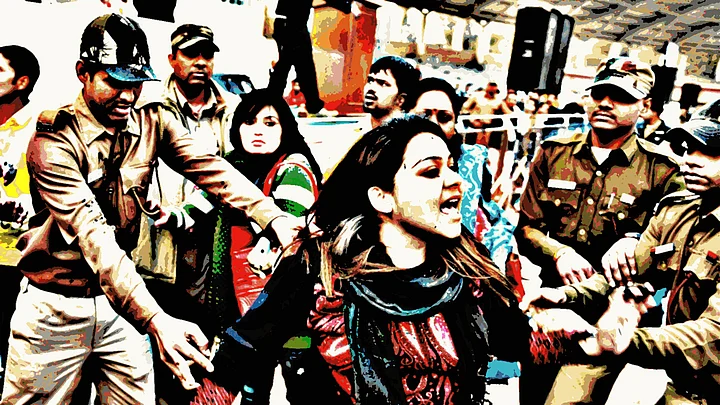In a democracy, people often find unusual ways of protesting – from throwing shoes, to pies, to custards. Why, even poor David Cameron was egged by a 16-year-old.
But back home, perhaps mooh kala karna is the biggest insult of all. Apart from painting the one you loathe black, literally, you can also guarantee yourself uninterrupted media space.
Besides, writing a letter or staging a dharna is an old-fashioned form of protest, innit?
And so, ink has become the most dramatic choice of weapon to express dissent. The most recent ink attack was on Delhi Chief Minister Arvind Kejriwal while he was addressing a rally on Sunday.
Last checked, Bhavna Arora, the woman who splattered ink on Kejriwal had been sent to 14-day judicial custody.
Delhi Police slapped four charges on Bhavna under IPC sections 186, 353, 355 and 504, with sections 186 and 353 related to obstruction to work of a public servant.
Police told the court they were charging her with obstruction of justice and assault and added that they wanted to crackdown on such ‘publicity stunts’.
CL Gupta, Complainant LawyerOrdinarily, there should be a bail in such cases, but this case isn’t ordinary. These types of incidents, meant mostly for publicity are increasing by the day. And a legal precedent has to be set for deterring such attacks. If people get out on bail after just a day, that will give further air to such incidents. People should know that by doing such acts, you can even go to jail.
Ink-Attacks Easy to Get Away With?
Abishek Kaul – practising lawyer of the Delhi High Court says the attacker can be charged with Section 503 (threatening to injure or harm someone’s reputation) and Section 504 (Intentional insult with intent to provoke breach of peace) of the Indian Penal Code. Both these are bailable offences, that are punishable up to 2 years in prison or a fine or both.
Abishek Kaul, LawyerIn very few cases does the Magistrate grant punishment. Usually, he may ask the accused to furnish bail or may simply impose fine on him/her.
Shankh Sengupta, Partner at Trilegal, says ink attacks are mostly a matter that the courts don’t take seriously and will award a judgement mostly to ensure that this isn’t done about frequently. But an attacker could be slapped with possible assault charges as per Section 355, resulting in imprisonment for up to two years.
On the other hand, Priya Hingorani, SC advocate, says it could be sufficiently argued that the mere act of throwing ink doesn’t come under assault unless you are able to prove that a person wanted to cause grievous hurt.
It entirely depends on the judge’s disposition and how good the lawyers are, really. But the Bhavna case is now being seen as reflective of the courts’ tough stance on ink attacks, which are becoming quite a rage among protesters, as one can gather.
Ink Attacks: Quite a Rage
Many have faced syahi over the years — from troubled business tycoons to beef-party organisers (Engineer Rashid, anyone?)
In March 2014, Manoj Sharma, who earlier hurled a shoe at Suresh Kalmadi, attacked Sahara Group “supremo” Subrata Roy, fondly known as Sahara Shri.
And in October 2015, Shiv Sena members allegedly blackened Sudheendra Kulkarni’s face. Kulkarni had fallen into the Sena’s black books for organising a book launch written by a former Pakistan Foreign Minister. (nuff, said!)
Sadly, Kejriwal has been a black sheep before too. He was attacked with ink during his Lok Sabha campaign in Varanasi back in March 2014.
But one question that still remains unanswered is that what is about black ink that makes it such a popular weapon of choice?
Let’s Hear It From the Sena
Because it is “non-violent”, silly! Or that’s what Yuva Sena chief Aaditya Thackeray seemed to imply while justifying their ink attack on Sudheendra Kulkarni.
For a party that thrashes couples and hits Kannadigas regularly, Party MP Sanjay Raut calls the act of smearing ink a “very mild form of democratic protest”.
Bollocks, say lawyers, and now maybe, even the courts.
(At The Quint, we question everything. Play an active role in shaping our journalism by becoming a member today.)
